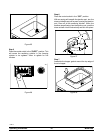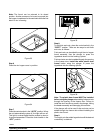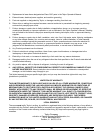
22
Model 220Important: Operator Checklist
051101
Section 7 Important: Operator Checklist
During Cleaning and Sanitizing
Cleaning and sanitizing s chedules are governed by
your State or local regulatory agencies and must be
followed accordingly. The following check points
should be stressed during the cleaning and sanitizing
operations.
We recommend that after the necessary
batches have been prepared for the day, the
machine be cleaned and sanitized.
ALWAYS FOLLOW LOCAL HEALTH CODES.
Troubleshooting Bacterial Count
j 1. Thoroughly clean and sanitize the machine
regularly, including complete disassembly and
brush cleaning.
j 2. Use all brushes supplied for thorough cleaning.
The brushes are specially designed to reach a ll
mix passageways.
j 3. Use the white bristle brush to cleanthe mix inlet
hole which extends from the mix hopper down
to the rear of the freezing cylinder.
j 4. Use the black bristle brush to thoroughly c lean
the rear shell bearing located at the rear of the
freezing cylinder. Be sure there is a generous
amount of cleaning solution on the brush.
j 5. Properly prepare the cleaning/sanitizing
solution. Read and follow the label directions
carefully. Too strong of a solution may damage
the parts and too weak of a solution will not do
an adequat e job of cleaning and sanitizing.
j 6. The temperature of the liquid mix should be
below 40_F. (4.4_C.).
j 7. The temperature of finished product to be
placed in a hardening cabinet should be
between 23_ and 25 _F(-5.0_ to - 3.9_C).
Regular Maintenance Checks
j 1. Replace scraper blades that are nicked or
damaged. Before installing the beater, be
certain that the scraper blades are properly
attached.
j 2. Check the rear shell bearing for signs of wear
(excessive mix leakage in rear drip pan) and be
certain it is properly cleaned.
j 3. Using a screwdriver and cloth towel, keep the
rear shell bearing and the female hex drive
socket clean and free of lubricant and mix
deposits.
j 4. Dispose of o- rings and seals if they are worn,
torn, or fit too loosely, and replace with new
ones.
j 5. Follow all lubricating procedures as outlined in
“Assembly”.
j 6. If your machine is air c ooled, check the
condenser for accumulation of dirt and lint. Dirty
condensers will reduce the efficiency and
capacity of the machine. Condensers should be
cleaned monthly with a soft brush.
Note: For machines equipped with an air filter,
it will be nec essary to vacuum clean the filters
on a monthly schedule.
Never use screwdrivers or other metal
probes to clean between the fins.
j 7. On water cooled units, check the water lines for
kinks or leaks. K inks can occur when the
machine is moved back and forth for cleaningor
maintenance purposes. Deteriorated or
cracked water lines should be replaced only by
an aut horized Taylor technician.


















